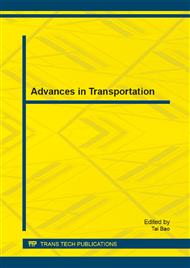p.1107
p.1114
p.1118
p.1122
p.1127
p.1133
p.1137
p.1143
p.1148
Empirical Analysis on Time to Collision at Urban Expressway
Abstract:
Traffic safety is of great significance, especially at urban expressway where traffic volume is large and traffic conflicts are highlighted. But little research up to date has discussed in detail how these factors impact the TTC characteristics. In this paper, field Beijing expressway data were collected by video with different locations, lanes, traffic conditions and following vehicle types. Accordingly, some basic descriptive statistics of total TTC samples were shown and analyzed. We then used T-test to analyze the effect of road environments, traffic conditions, and vehicle types on TTC statistically. The results implied three main findings. Firstly, TTC was found to change according to road environments (i.e. TTC on weaving segment is smaller than other locations), secondly, some evidence supported this hypothesis that traffic conditions (especially uncongested traffic condition) affect TTC significantly, and lastly, little correlation was found between TTC means and vehicle types.
Info:
Periodical:
Pages:
1127-1132
Citation:
Online since:
January 2014
Authors:
Keywords:
Price:
Сopyright:
© 2014 Trans Tech Publications Ltd. All Rights Reserved
Share:
Citation:


